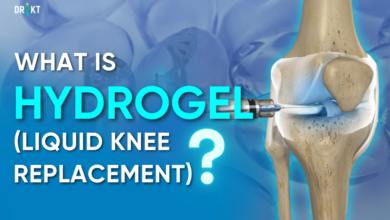Recovery After Prosthesis Surgery: A Comprehensive Guide
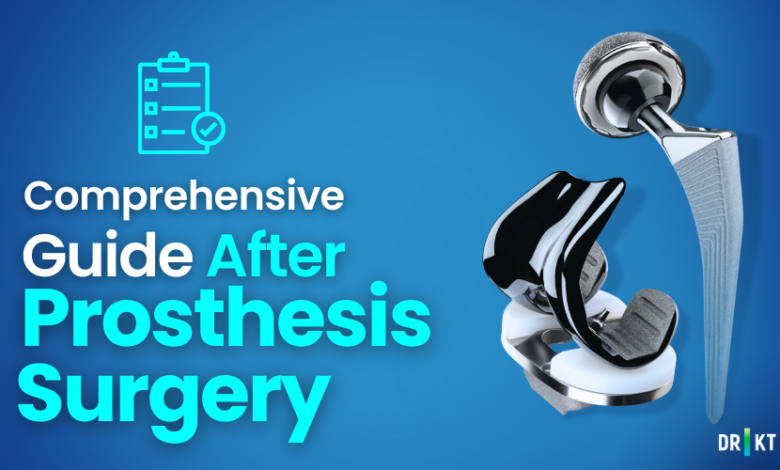
The hip and knee joints are joints that are actively used in everyday life. Due to arthritis or trauma, these joints may not be used as actively as before. In this case, prosthetic surgery may be necessary to restore the joints to their former function. Prosthesis surgeries are performed to improve patients’ quality of life and reduce their pain. Patients can then return to their daily lives, work or favorite pastimes.
Prosthetic surgery is a permanent treatment. However, patients also have a number of responsibilities for the successful completion of the healing process. The healing process actually starts with preoperative preparations. After surgery, patients should learn what to expect and take precautions accordingly. It is important to remember that recovery is a time-consuming process and that there are different needs at each stage.
Contents:
Expectations from Surgery
Expectations are one of the most important factors determining patient satisfaction after prosthesis surgery. If the preoperative expectations are not met after surgery, patients may feel that the surgery was unsuccessful. However, the results of prosthesis surgery vary according to the patient’s condition.
Your pre-operative pain, state of health and level of function will affect the outcome of the surgery. For example: If you experience severe pain; if you have obesity, diabetes, hypertension, heart disease, etc.; if you smoke, you may experience more pain after surgery and your level of function may be lower.
It is very important to develop realistic expectations to avoid any disappointment after surgery. When planning your treatment with your doctor, you should discuss the consequences of prosthetic surgery in detail. If you set your expectations realistically, you will be more satisfied with the results. By being aware of what to expect, you can adapt to your new life more easily.
First 24 Hours After Surgery
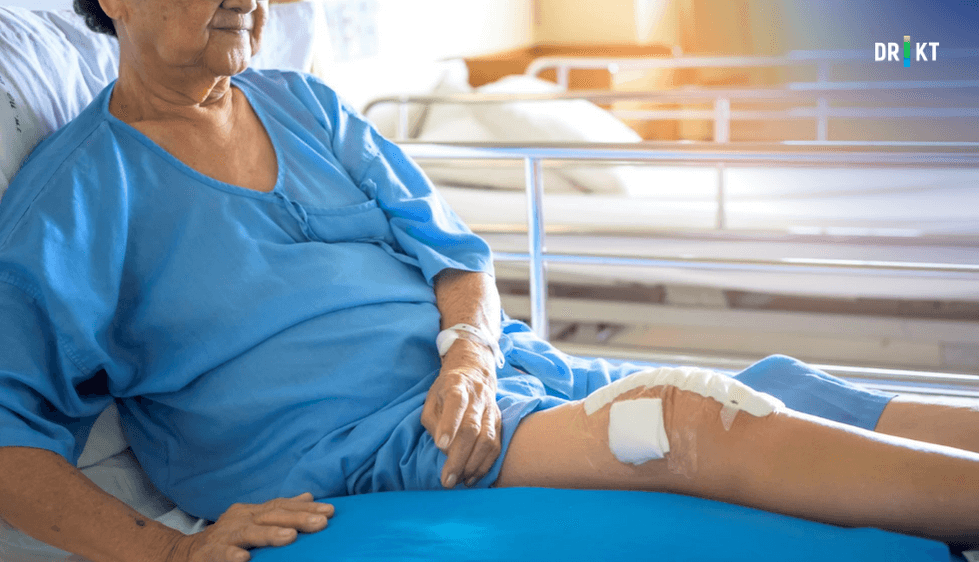
Monitoring Vital Signs: After you come out of surgery, your vital signs (heart rate, blood pressure, etc.) and any side effects from the anesthesia (such as vomiting) will be monitored first. Various medications are given. These medicines can include painkillers, blood thinners and antibiotics to prevent infection.
Physiotherapist Guided First Movement: A few hours after surgery, you can get out of bed with help. Your physiotherapist will accompany you and help you to walk with the help of an orthopedic device such as a walker. This improves your blood circulation and reduces the risk of blood clots. So the rehabilitation process starts immediately after surgery. However, in some cases, patients may not be able to stand up immediately due to other conditions (such as blood pressure). Therefore, she can walk the day after surgery.
Case-specific Rehabilitation Plan: After the surgery, your physiotherapist will give you training on what to do in the hospital and at home. This training includes how to get in and out of bed, how to use orthopedic devices, how to climb stairs after knee replacement surgery and exercises you should do. Your physiotherapist will also provide guidance on how much load you should place on the operated area, the lying, sitting and bending positions after prosthesis surgery. Your accompanying person should also listen carefully to this training. You usually need to start exercises within 24 hours after surgery. Following the exercise plan will help you return to your normal activities faster.
CPM Device
Your doctor may recommend using a CPM (Continuous Passive Motion) device after hip replacement surgery or knee replacement surgery. The CPM device helps to gently bend and flatten the operated area. Thus, it is aimed to prevent postoperative complications such as edema and pain, and to increase range of motion and joint functionality. The CPM device also contributes to a faster discharge.
Within 24 hours after surgery (usually before discharge), use of the CPM device can be started. The CPM device can be applied up to 8 hours a day, excluding sleep and physical therapy. In some cases, it may be necessary to use it at home after discharge. On average, it is continued for 2 weeks.
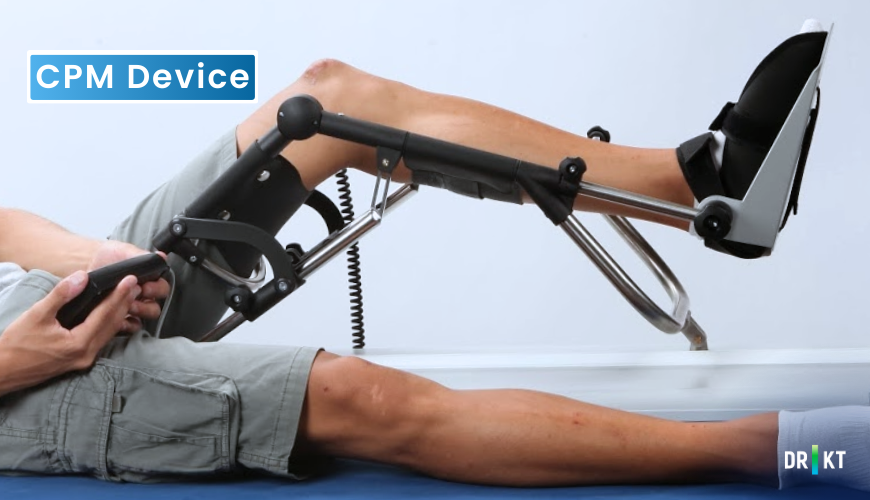
DVT Treatment Device
The DVT treatment device is a special device designed to increase blood flow and reduce the risk of DVT (Deep Vein Thrombosis), a blood clot in deep veins. This device is recommended for patients who have undergone major surgery, have been in intensive care for a long time or may be immobilized at home.
Deep vein thrombosis (DVT) is a blood clot that forms in veins deep inside the body. In most cases, this clot appears in one of the veins in the lower leg. The veins in the legs have small valves that help the blood to move towards the heart. DVT (Deep Vein Thrombosis) can damage these valves. In more advanced stages, it can reach the lung and cause pulmonary embolism (lung clot).
The DVT treatment device has cuffs that wrap around the legs. These cuffs fill with air and squeeze the legs. This increases blood flow and eliminates the risk of blood clots. The DVT treatment device can be started immediately after surgery and used for 1 week.
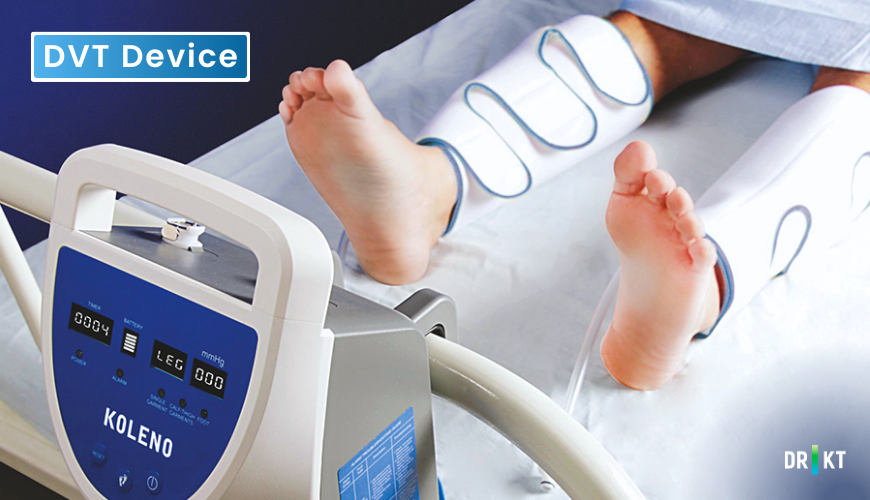
Hospital Discharge Process
Your hospital stay may vary from 1 to 4 days, depending on the speed of your recovery. However, if you are discharged before reaching a certain stage, it may have a negative impact on your recovery. Therefore, you are expected to meet the following criteria for discharge:
- Getting in and out of bed on your own
- Reducing your pain to acceptable levels
- Being able to eat and drink fluids
- Using the toilet after prosthesis surgery
- Walking short distances with the help of an orthopedic device (such as a walker, cane or crutches)
- Climbing up and down two to three flights of stairs after surgery
- To be able to do the exercises given for the home
- To understand the necessary precautions to prevent accidents such as falls
If you are not yet able to do the above skills, it may not be safe for you to be discharged. This may prolong your hospital stay. Getting the support and care you need for your recovery can lead to a more effective recovery in the long term.

First 2 weeks at home after surgery
The first 2 weeks at home after surgery is one of the most important stages. At this stage, it is necessary to pay attention to issues such as care of the surgical wound, personal care, exercise and avoid activities that pose a risk of falling. Apart from these, necessary precautions should be taken to avoid conditions such as infection and blood clots.
On average, your stitches are removed 14 days after surgery. This period may be longer depending on your situation. Until your stitches are removed, you should pay attention to a number of issues regarding wound care. If you are not careful, there is a risk of infection.
Since you will not be able to shower during this period, you should take a sponge bath to keep your body and the area around the wound clean. However, you must not get any liquid on your stitches and wound area. You should renew your dressing and change the bandage as recommended by your doctor.
After your stitches are removed, you can take a bath or shower and start walking without an orthopedic device. The first days after surgery can be a bit challenging. However, as the day goes on, you will start to move more freely and do your daily chores more easily.
Wound Care After Prosthesis Surgery
Proper and attentive care of your surgical wound during your recovery at home is important to prevent infection. You should follow these general recommendations for the correct care of your surgical wound:
- Keep the wound area clean and dry.
- After the first dressing is removed, you can shower with a waterproof dressing.
- Dressing and bandaging of the surgical wound is first applied in the operating room. On average, the dressing needs to be renewed and the bandage changed every 3-4 days.
- In some cases (such as discharge) it may be necessary to apply dressings and change the bandage every day. For this procedure, you can go to a full range of health centers. It can also be done at home if the necessary hygienic conditions are met.
- Surgical sutures are removed in the clinic. In some cases, the stitches do not need to be removed because they are placed under the skin.
- Do not immerse the wound in water until 6 weeks after surgery. So do not enter the water in environments such as bathtubs, pools and the sea.
If you have symptoms such as redness, warmth, discharge, swelling, severe pain that does not go away despite painkillers or odor in the area of your surgical wound, you may have an infection. Always consult your doctor in such cases.
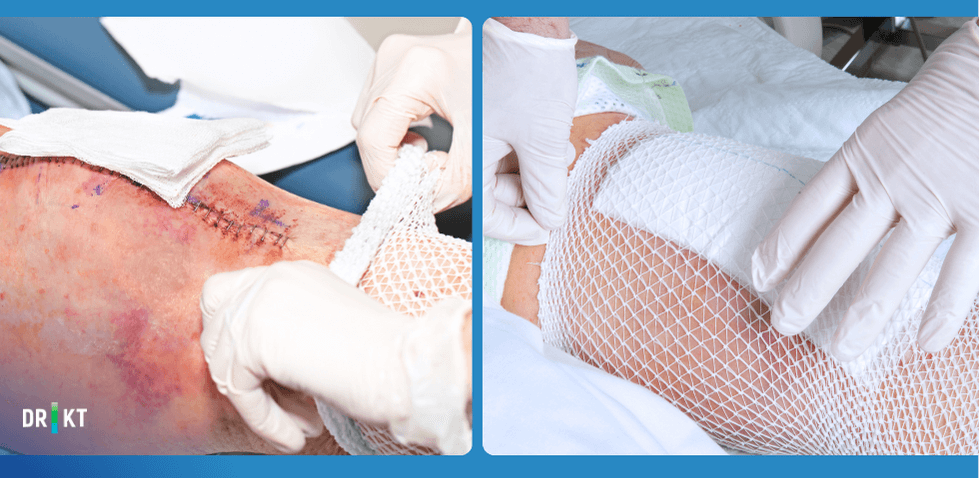
Normal Postoperative Symptoms
Pain, swelling and bruising after knee or hip replacement surgery are part of the healing process. Patients will notice that these symptoms improve rapidly within the first weeks. Nevertheless, there are things patients can do to manage pain, swelling and bruising. What to do in case of symptoms will be discussed in the following chapters.
Normal symptoms that can be seen after surgery are as follows:
- There may be pain for a few weeks after surgery.
- Swelling after surgery usually lasts 2-3 weeks. But it can also last between 3 and 6 months.
- Bruising may last 1 to 2 weeks after surgery.
- After the operation, you may hear a noise in your knees or hips. This is usually not caused by a problem and decreases over time. However, if it is accompanied by pain, swelling or joint deformity, you should consult your doctor.
Postoperative Pain Control
One of the goals of knee and hip replacement surgery is to relieve severe pain. However, in the days following surgery, patients may experience more severe pain than before surgery. Severe pain after prosthesis surgery is normal and usually temporary. Nevertheless, appropriate interventions should be made. If these interventions are not carried out, the healing and rehabilitation process may be hampered.
There are many ways to manage pain. Your doctor will advise you on the most appropriate pain control methods for your situation. The following methods can be used to relieve postoperative pain.
- Medication: You can control your pain with medicines recommended by your doctor. Opioid painkillers are very effective. However, it can be used when pain is at its most intense. It is necessary to switch to non-opioid painkillers as soon as possible because they have side effects.
- Ice Application: Applying cold to the painful area numbs the nerve endings, reduces swelling, inflammation and pain.
- Activity: Spending too much time lying down or sitting in one position can cause pain, muscle cramps and fatigue. Being physically active shortens your recovery time and reduces your risk of blood clots.
- Rest: Being active and mobile is important for your recovery. However, you should not engage in more activity than your body can tolerate. It is very important to rest after an appropriate amount of movement.
- Aromatherapy: Aromatherapy uses essential oils to stimulate your body’s natural ability to relax and heal. Research has shown that the use of aromatherapy can help reduce pain, anxiety, nausea and insomnia (imsomnia).
- Massage: Massage helps to reduce muscle tension, stress and pain. It can only be done after the stitches are removed.
- Efloraj (Gentle Massage): Efloraj is a type of massage that involves little or no pressure. In this massage, you use gentle strokes on your skin to relax your muscles and increase blood flow. You can also do gentle massage after the stitches have been removed.
- Shower: You should not expose the injured area to any liquid until your stitches are removed. However, taking a hot shower after your stitches are removed can reduce your pain, relax your muscles and help you relax.
- Breathing Techniques: You can reduce your pain with breathing techniques that help you relax. Because when you practice certain breathing techniques, your heart rate slows down, your blood pressure decreases and the blood flow to your muscles increases.
- Environment Changes: Simple changes such as dimming the lights, lowering the curtains, turning off the TV and adjusting the temperature of your room can help you rest better.
- Changing position while lying down: If you often rest in bed, change position at least every 2 hours. Having your hips, back and head in proper alignment is a good way to relieve muscle strains and back pain.
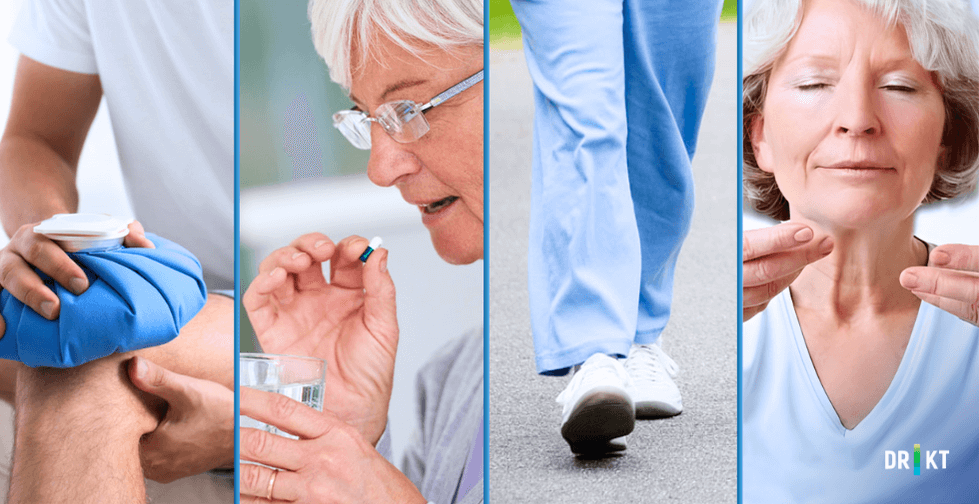
Postoperative Swelling Management
Swelling in the leg after prosthesis surgery is a normal condition that can be seen during the healing process. So it should not be a cause for concern. For 6 months after surgery, swelling may continue to decrease.
The methods you can apply to reduce swelling are as follows:
- Exercises: You can reduce your swelling by practicing the exercises recommended by your physiotherapist.
- Keeping your leg elevated: Keeping your leg elevated as recommended by your doctor can help reduce swelling.
- Ice Application: Ice application or cold compresses are a very effective method to reduce swelling and inflammation in the operated area.
If you develop a new and severe swelling while you are recovering, be sure to tell your doctor. Because this can be a sign of infection.
Bruising Management After Prosthetic Surgery
Bruising in the knee or hip area may persist for 1 to 2 weeks after surgery. Bruising is a discoloration caused by the accumulation of blood under the skin. Your doctor will prescribe blood thinners to reduce the risk of deep vein thrombosis after surgery. This can increase bruising.
Bruising is a normal part of the healing process and will reduce over time. Keeping the legs elevated can reduce inflammation and bruising. Always consult your doctor if your bruising develops unexpectedly.
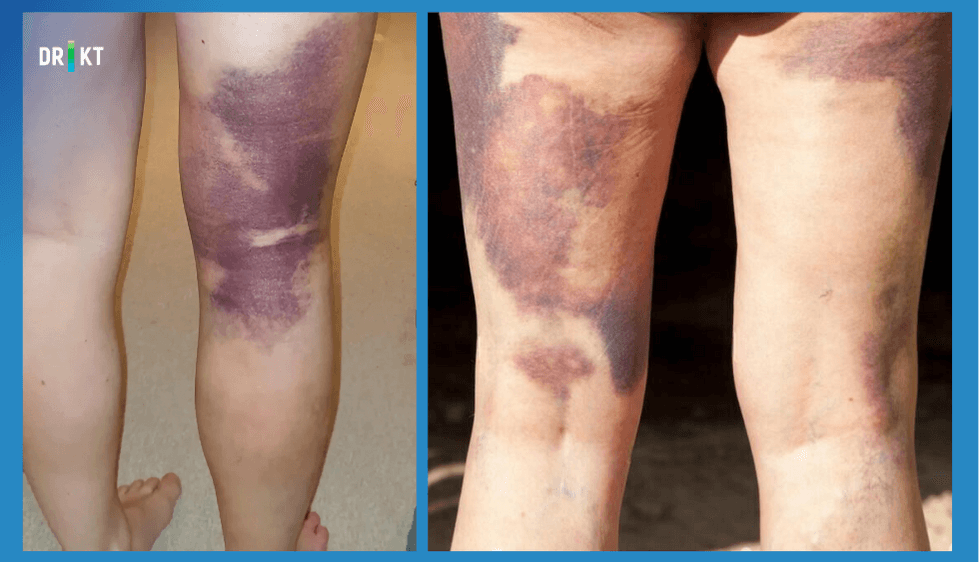
Problems that can be seen after surgery
Knee and hip replacement surgeries performed with today’s technology are safe. However, as with any surgery, there is a risk of complications in these procedures. Whether there will be complications depends on factors such as your general health, your age and whether you follow your doctor’s recommendations. Throughout your treatment, your doctor will inform you about the risks of complications and guide you to take precautions.
Blood Clot or Deep Vein Thrombosis (DVT)
There is a possibility of developing a blood clot or deep vein thrombosis after surgery. While this may seem harmless, if it reaches the lungs or brain it can have serious consequences. Symptoms of deep vein thrombosis usually appear two weeks after surgery. These symptoms usually appear in a specific area of the leg and are as follows:
- Redness
- Swelling
- Pain
- Temperature
The following methods can be used to reduce the risk of blood clots:
- DVT treatment device use
- Lower leg exercises
- Keeping the legs elevated
- Regular movement instead of sitting for long periods of time
- Use of blood thinners
Infection After Prosthesis Surgery
If bacteria get into the operated joint, infection occurs. As with any surgical intervention, there is a risk of infection after prosthesis surgery. Although infection is rare, it is a serious complication. Therefore, it is a situation that requires urgent intervention. Symptoms of infection in the wound area are as follows:
- Redness, swelling or warmth at the surgical site
- Severe pain or tenderness
- Odor
- Discharge or opening of stitches
- Fever or feeling generally ill
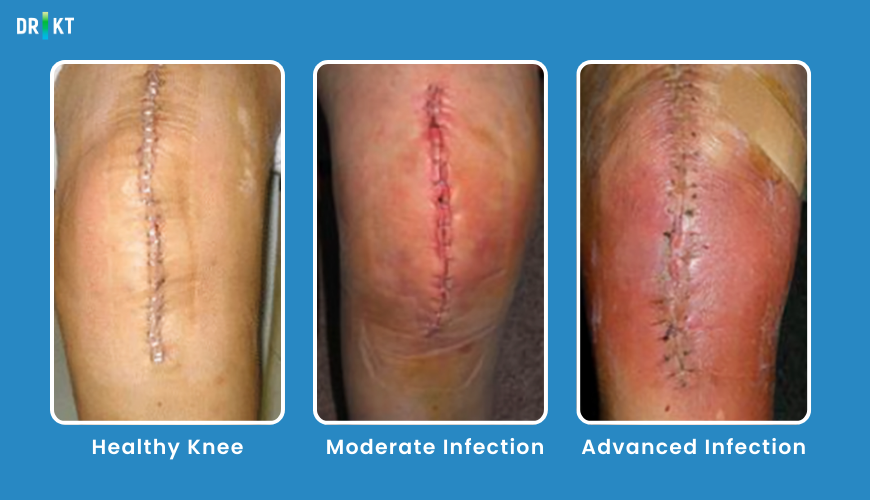
It is important to follow your doctor’s advice after surgery to reduce the risk of infection. Your doctor will make the following recommendations for you:
- You should pay attention to your general hygiene before surgery and take measures to protect your general health.
- You should stop smoking 4 weeks before surgery and stop drinking alcohol 2 weeks before surgery.
- You should use the antibiotics given before and after the operation regularly.
- Until the stitches are removed (on average for the first 2 weeks), you should care for the wound hygienically and carefully.
Postoperative Medication Use
Certain medications are prescribed to help you manage the post-operative recovery process in the best possible way. When prescribing your medication, your doctor will make a special arrangement for your particular case. The use of medication, together with other methods such as physiotherapy, will enable you to return to physical activities. Medication is used to reduce pain, manage side effects, prevent blood clots and infection.
Reducing Pain
If your postoperative pain is intense, you may find it difficult to start the rehabilitation process and start moving. This will hamper your healing process. With the painkillers prescribed by your doctor, you may be ready to move more easily and start physical therapy.
Managing Side Effects of Medicines
The medicines you use after surgery may cause some side effects. According to one study, 55% of patients needed treatment for nausea, vomiting or constipation after surgery. Therefore, you can use anti-nausea or stool softening medicines with your doctor’s approval. You should not take any medicine that your doctor has not prescribed or approved.
Blood Thinners
There is a risk of blood clots forming after knee or hip replacement surgery. A clot that forms in deeper blood vessels is called deep vein thrombosis. In some cases, the blood clot can break off and travel around the body. If it reaches the lungs, it can cause pulmonary embolism (lung clot), and if it reaches the brain, it can cause a stroke. Blood thinners and compression devices are prescribed to prevent this condition.
Preventing Infection
After surgery, an infection may develop in the prosthetic joint area due to other infections in the body or for an unknown reason. Usually the patient’s immune system eliminates harmful bacteria that can cause infection. However, in people with a weak immune system, the infection may involve the prosthesis site. Your doctor may prescribe antibiotic medication before and after surgery to prevent infection.
People with diabetes, obesity, circulatory problems and conditions that affect the immune system, such as HIV, are at higher risk of infection.
If you notice signs of infection at the surgical site, you should contact your doctor immediately. Infections detected early can usually be treated quickly.
Physical Therapy and Exercise
Starting a physical therapy and exercise program after prosthesis surgery is important to manage your recovery effectively. You can ensure that your knee/hip joint gains strength, movement and flexibility with a customized program. Therefore, you should definitely participate in a physical therapy and exercise program to meet your expectations after surgery.
The rehabilitation process starts from the moment you wake up after surgery. The exercises you start in the hospital will continue at home after discharge. Studies have shown that starting rehabilitation within the first 24 hours after prosthesis surgery contributes to pain control and early recovery.
You may have difficulty moving your knee/hip after surgery. For this reason, you may be avoiding physiotherapy treatments or exercises. If you take the painkillers recommended by your doctor, you will be able to continue your program more easily. You can also motivate yourself by thinking about the benefits of exercise.
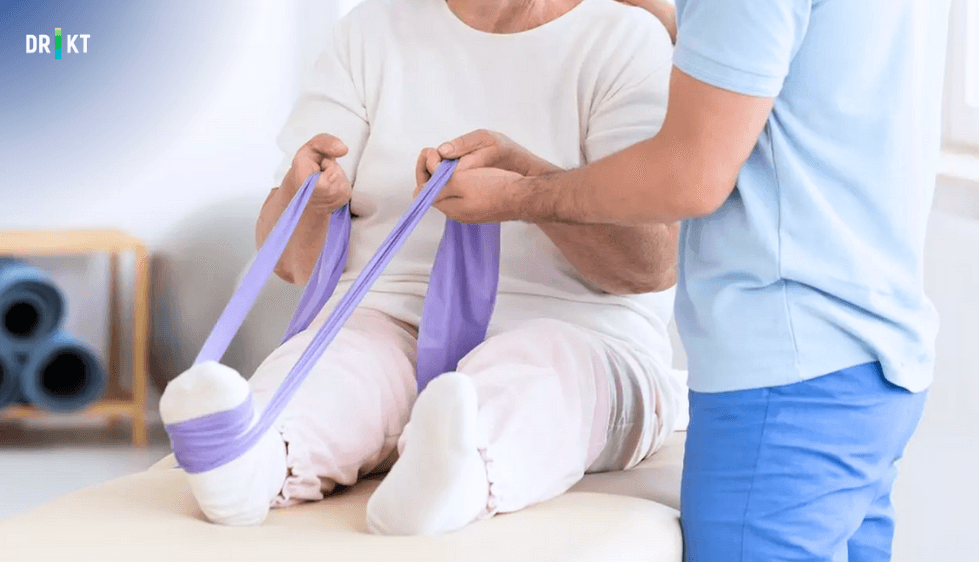
The benefits of a physical therapy and exercise program are listed below.
- Your pain will be relieved.
- Your inflammation (inflammation) is reduced.
- Your circulatory system works.
- You regain your joint strength and mobility.
- The supporting peripheral muscles in your knee and hip joint are strengthened.
- Physical therapy can help relieve joint and muscle stiffness.
- Your balance skills will improve.
- Your gait will improve.
- You can return to your normal level of movement and activities.
It is normal to feel some soreness or swelling after exercises. Stopping exercise because of symptoms that are considered normal can slow down your recovery. To manage post-exercise pain, it may help to use recommended medication or apply ice. However, if you find the exercises too difficult, stop and consult your doctor.
Everyday Life After Surgery
Movements to Avoid
The movements you should avoid after hip and knee replacement surgery may vary.
You should be careful in the following situations after knee replacement surgery:
- In the first period after surgery, do not do activities that may sprain your knee or put extra strain on your knee.
- Although the exercise program is important, if you feel pain when bending or straightening your knee, don’t force it. You can gradually increase the level of movements you need to do.
- Take small steps when turning somewhere. Avoid turning on the operated leg.
- Do not move your operated leg suddenly.
The conditions that you should pay attention to in the process after hip replacement surgery are as follows:
- Do not cross your legs for at least 6-8 weeks after your surgery.
- Do not lift your knee higher than your hip.
- Do not lean forward when sitting or when you are about to sit.
- Do not try to pick something up from the floor while sitting.
- Do not turn your feet inward or outward excessively when bending over.
- When lying on your bed, do not bend down to pull the blanket.
- Be careful not to bend your lower back more than 90 degrees.
Bathing After Prosthetic Surgery
It is important to make appropriate preparations before surgery and to organize your bathroom for the postoperative period. The bathroom should be made safe as it is an area where there is a high risk of falls. Tools such as grab bars or bath seats can be used for this.
It is not recommended to take a bath after the operation until the stitches are removed. Because the surgical wound should not come into contact with any liquid until it heals. However, on average, you can take a bath 2 weeks after surgery (when the stitches are removed). This period may vary according to each patient’s condition.
You can enter and exit the bathroom in different ways depending on the bathroom layout in your home. If you have a bathtub at home, you can take a bath by following the instructions below:
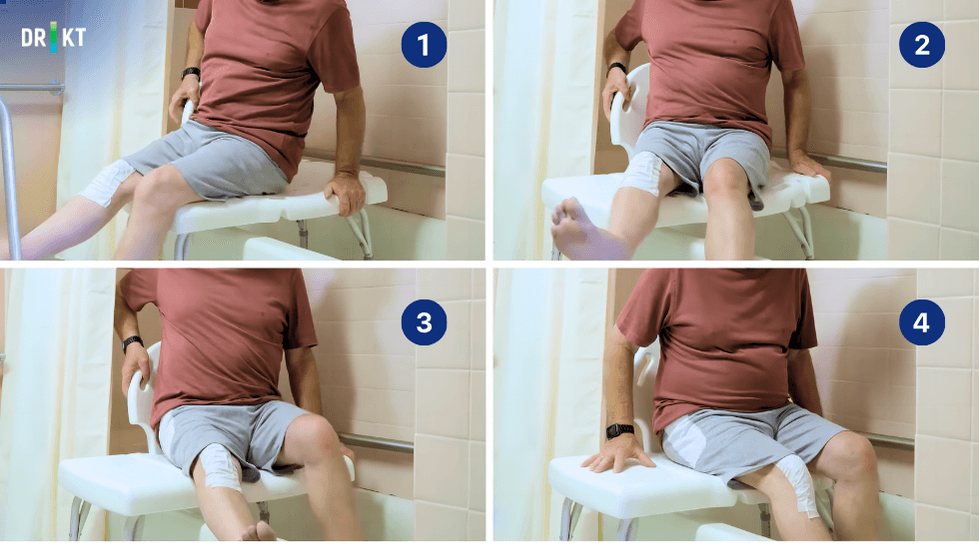
- To make it easier to get in and out of the bathtub, you should first get a bathtub transfer bench.
- Place the bathtub transfer bench in a suitable position.
- Sit on the tub transfer bench with your back to the tub.
- Turn into the tub and take turns lifting your legs up and in.
- Follow the same steps in reverse when getting out of the bathtub.
If you have a shower cabin in your home, you can take a bath by following the steps below:
- It is recommended to get a bath chair first.
- When getting in and out of the shower, move by stepping sideways.
- Sit on the bath chair during the shower.
- For a safe bathroom, you can get non-slip bath mats and wall-mounted grab bars.
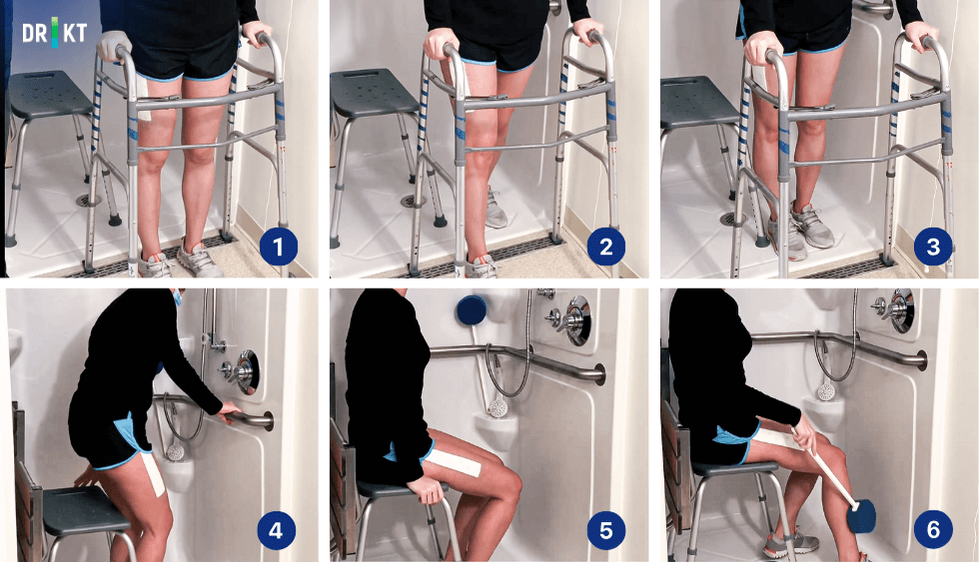
Dressing
When getting dressed after prosthesis surgery, you should pay attention to the following points:
- Avoid wearing pants while standing. Because this way you are more likely to fall and you may have difficulty because you may have to bend down. Sit on a chair or on the edge of the bed for a more stable position.
- You can use devices (such as a shoehorn) to help you get dressed without bending over too much.
- Put your clothes on first on the operated side (such as pants or socks).
- When taking off your clothes, take them off first on the non-operated side.
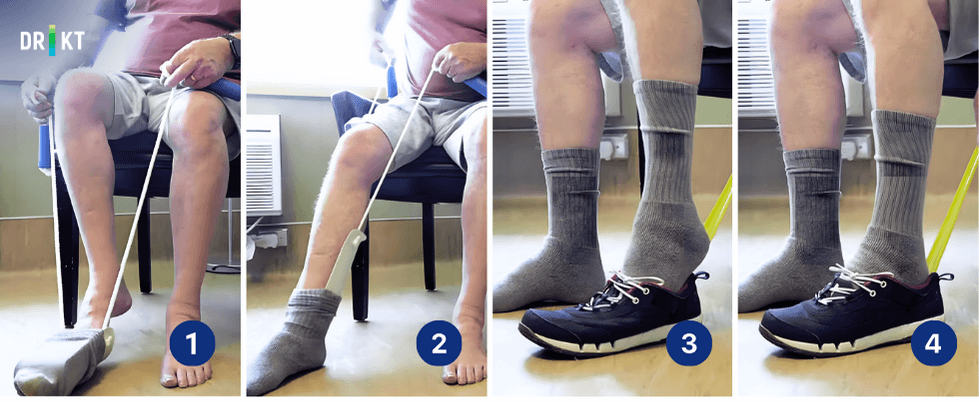
Sleep Position
There may be differences in the optimal and safe sleeping position after hip and knee replacement surgery.
Recommendations for lying position after hip replacement surgery are as follows:
- Lying on your back is the best position for sleeping. When you sleep on your side, you should not lie on the operated area.
- When not lying on your back, make sure that your legs or ankles do not overlap.
- Avoid bending your knees while sleeping.
- Put a pillow between your knees. Avoid placing pillows under your knees.
- Avoid sleeping on your stomach.
- You can change position if you feel uncomfortable.
- Do not turn your legs or toes inwards.
The safest sleeping position recommendations after knee replacement surgery are as follows:
- Lying on your back is the best position for sleeping. Thus, your legs are straight and blood flow to the surgical site is ensured easily.
- You can put a pillow under your leg to prevent your knee from bending and to provide support.
- You should not sleep on your side until you are able to bend your knees (about a few weeks after surgery). When you can lie on your side, you should not lie on the operated area.
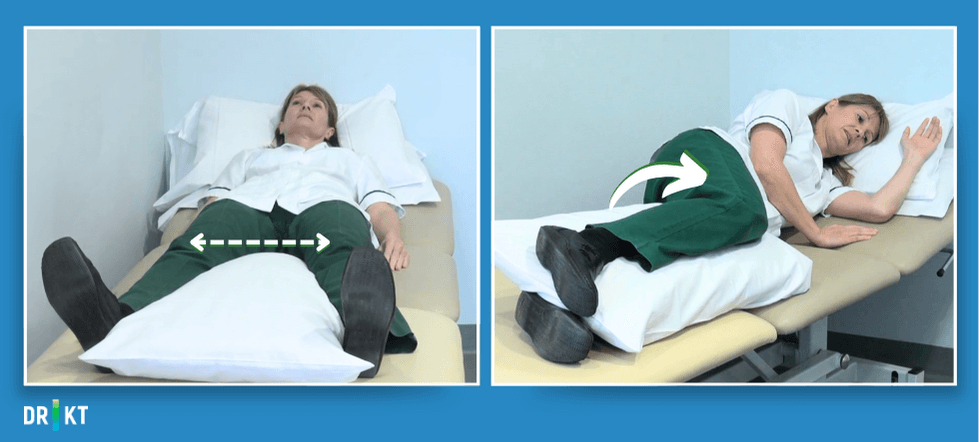
Back to Work
Depending on how much physical activity your job involves and how your recovery progresses, it can take anywhere from a few days to several weeks to return to work. You should consult your doctor about the safest date to return to work.
Back to Sport
You should follow the exercise program created by your physiotherapist for at least 2 months. In some cases, an exercise bike is also recommended to increase your knee/hip flexibility and strengthen your muscles. 3-6 months after your surgery, you can be more active in daily activities. You can return to sports that do not put too much strain on your knees or hips.
Another important issue to be aware of when returning to sports is the risk of falling. If you have an accident or fall during sports, your recovery can be negatively affected. Therefore, you should avoid sports involving close contact and take measures to eliminate the risk of falling.
You should pay attention to the following points about returning to your sporting life:
- You can walk as far as you want. However, walking is not a substitute for the exercises recommended by your physiotherapist.
- One of the best physical activities after prosthesis surgery is swimming. Once your surgical wound has healed, you can start swimming again.
- It is recommended to do low-impact exercises such as golf, cycling and doubles tennis instead of sports that involve jumping, running and fast changes of direction, such as basketball, skiing and singles tennis.
You should discuss in detail with your doctor which sports will be suitable for you after prosthesis surgery.
Driving a Car
When you are not taking opioid pain medication and your strength and reflexes are better, it is safe to drive. Everyone develops safe conditions for driving at a different time. On average, however, you can drive 4 to 6 weeks after knee replacement surgery. After hip replacement surgery, you can drive a car after a few weeks or a month. You should always consult your doctor to determine the most appropriate driving date after surgery.
Nutrition After Prosthesis Surgery
Eating a balanced and healthy diet ensures that your body gets all the vitamins, minerals and nutrients it needs during the healing process. Our bodies absorb vitamins and minerals from food more efficiently than from supplements. This is why nutrients taken directly from natural foods are important.
You should definitely consult your doctor and dietitian about the most appropriate diet after surgery. Depending on your condition, they may recommend a diet that you must follow. The following headings contain general nutrition recommendations.

Drinking Water
After surgery, you will have anesthesia and many medicines in your body. These medicines tend to cause dehydration (dehydration). Therefore, fluid replacement after knee or hip replacement surgery is vital. The more water you drink, the faster you can flush the medicines out of your body. Drinking plenty of water also helps prevent constipation, a common side effect of anesthesia and some painkillers.
Electrolytes
Electrolytes are minerals that conduct an electric charge when combined with water. They help regulate our body’s most basic functions (such as PH balance, muscle contraction and hydration). Drinking too much water without getting enough electrolytes or fluid changes caused by anesthesia during surgery can disrupt the electrolyte balance. To maintain electrolyte balance, you can consume electrolyte-rich foods containing calcium, sodium, chloride, phosphorus, magnesium and potassium.
Chewing Gum
Chewing gum can be preferred to increase gastrointestinal motility and facilitate digestion. It may also be recommended to prevent constipation, which is a common side effect of certain medications after anesthesia and surgery.
Alcohol Use
Drinking alcohol causes your body to become dehydrated (dehydration). It also interacts negatively with some medications used after surgery. After stopping the medication, you can drink alcohol in moderation, if your doctor agrees.
Foods Rich in Iron
Iron-rich foods can be useful to compensate for blood loss during surgery. Because iron-rich foods contribute to the formation of blood stores. These include red meat, green leafy vegetables (such as spinach and kale), beans and dried fruits.
Anti-Inflammatory Diet
It is very effective to pay attention to nutrition to prevent inflammation in the operated area. Foods high in antioxidants (generally dark red in color) such as pomegranates, red cherries and beets help prevent inflammation. In addition, a typical “Mediterranean diet” of fish, fruits, vegetables, nuts, seeds, beans and olive oil is one of the most favorable anti-inflammatory diets. Processed sugar should be avoided. Because processed sugar increases inflammation.
Eating to Take Medicine
Solid food must be consumed before taking medication. Because the food taken before the medicine protects the stomach and helps prevent nausea.
Postoperative Dental Treatment
If you need treatment for your teeth, you should complete the procedures at least six weeks before the denture surgery. You should not have any dental treatment until three months after your surgery. This is because bacteria can enter your bloodstream if you have dental treatment within the time limits mentioned. This can lead to infection of the joint prosthesis. If you are having dental treatment after having denture surgery, your doctor may recommend antibiotics to reduce the risk of infection.
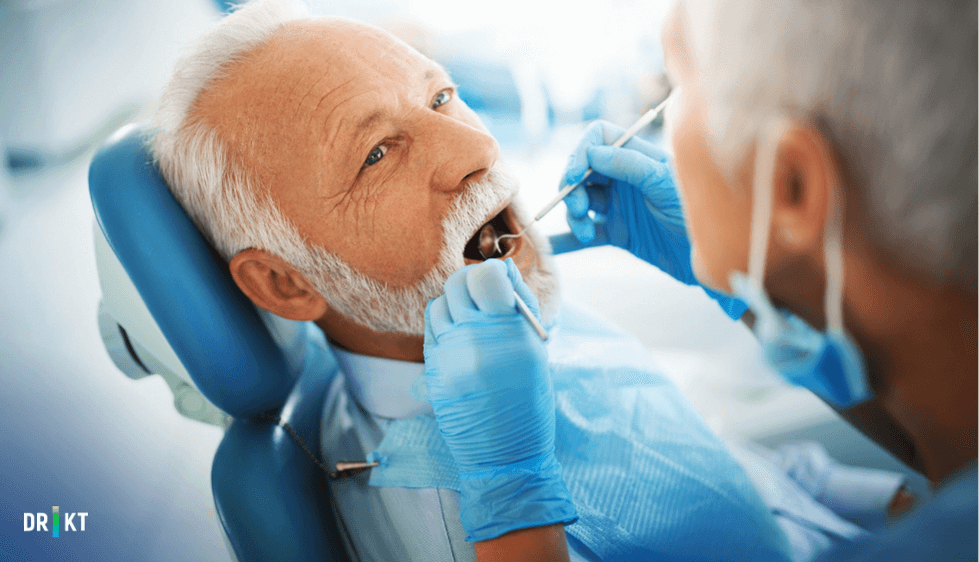
After Surgery Week 2 and 3rd Month Interval
You may not need to use orthopedic supports for walking 3-6 weeks after surgery. However, if you are using it (e.g. a cane) you can hold it on the opposite side of your new knee or hip. So you can improve your gait and rebalance your weight. You can also resume light activities. For example, if you have stopped taking painkillers, your doctor may allow you to drive again.
If you stick to your physical therapy program, you may notice a big improvement in your movement and strength. The swelling and inflammation are almost gone. At this stage, your physical therapy exercises will continue to improve your range of motion and increase your strength. However, physical therapy is usually completed 2 months after surgery.
After Surgery 3. Moon and 1. Between Year
While you are recovering, you should walk frequently every day and avoid sitting for long periods of time. Being mobile will reduce your pain and prevent stiffness in the surgical area. During this process, your pain will be further reduced and your mobility will improve.
You can start doing many of your normal activities again. However, it takes up to 12 months to fully recover. One year after surgery, most patients will not feel any pain. However, some patients may continue to experience mild pain or discomfort after one year.
Conclusion
The experience of the doctor, the technology and the method used are of great importance for a successful knee or hip replacement surgery. However, one of the people with the greatest responsibility for successful surgery is the patient. If patients follow the recommendations made both before and after surgery, they are very unlikely to have problems.
In our article, we touched on many topics such as wound care, exercises, medication, nutrition and daily life during the recovery period after surgery. You can contact us for any questions you are curious about and cannot find the answer. You can send your questions via our social media accounts or our website.

